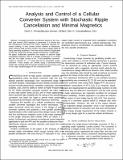| dc.contributor.author | Perreault, David J. | |
| dc.contributor.author | Kassakian, John G. | |
| dc.date.accessioned | 2014-05-09T17:02:35Z | |
| dc.date.available | 2014-05-09T17:02:35Z | |
| dc.date.issued | 1997-01 | |
| dc.identifier.issn | 08858993 | |
| dc.identifier.other | INSPEC Accession Number:5487680 | |
| dc.identifier.uri | http://hdl.handle.net/1721.1/86915 | |
| dc.description.abstract | A parallel converter architecture based on the resonant pole inverter (RPI) topology is presented. It is shown that this architecture minimizes the output magnetics required for current sharing. A new current control scheme is introduced which reduces peak currents, losses, and output voltage ripple for many operating conditions. This new control method is applicable to both the single RPI and the parallel architecture. Additionally, the paper analytically quantifies the degree of passive ripple cancellation between cells of a parallel architecture. It is shown that the RMS ripple current of an N cell paralleled converter system is a factor of 1√(N) lower than for an equivalent single converter. These results are verified using a piecewise-linear model. We conclude that the parallel architecture overcomes some of the major disadvantages of the conventional RPI. | en_US |
| dc.description.sponsorship | Bose Foundation | en_US |
| dc.language.iso | en_US | |
| dc.publisher | Institute of Electrical and Electronics Engineers (IEEE) | en_US |
| dc.relation.isversionof | http://dx.doi.org/10.1109/63.554180 | en_US |
| dc.rights | Article is made available in accordance with the publisher's policy and may be subject to US copyright law. Please refer to the publisher's site for terms of use. | en_US |
| dc.source | Vabulas | en_US |
| dc.title | Analysis and control of a cellular converter system with stochastic ripple cancellation and minimal magnetics | en_US |
| dc.type | Article | en_US |
| dc.identifier.citation | Perreault, D.J., and J.G. Kassakian. “Analysis and Control of a Cellular Converter System with Stochastic Ripple Cancellation and Minimal Magnetics.” IEEE Trans. Power Electron. 12, no. 1 (1997): 145–152. | en_US |
| dc.contributor.department | Massachusetts Institute of Technology. Department of Electrical Engineering and Computer Science | en_US |
| dc.contributor.department | Massachusetts Institute of Technology. Laboratory for Electromagnetic and Electronic Systems | en_US |
| dc.contributor.approver | Perreault, David J. | en_US |
| dc.contributor.mitauthor | Kassakian, John G. | en_US |
| dc.contributor.mitauthor | Perreault, David J. | en_US |
| dc.relation.journal | IEEE Transactions on Power Electronics | en_US |
| dc.eprint.version | Final published version | en_US |
| dc.type.uri | http://purl.org/eprint/type/JournalArticle | en_US |
| eprint.status | http://purl.org/eprint/status/PeerReviewed | en_US |
| dspace.orderedauthors | Perreault, D.J.; Kassakian, J.G. | en_US |
| dc.identifier.orcid | https://orcid.org/0000-0002-0746-6191 | |
| dc.identifier.orcid | https://orcid.org/0000-0002-3443-5702 | |
| mit.license | PUBLISHER_POLICY | en_US |
| mit.metadata.status | Complete | |
